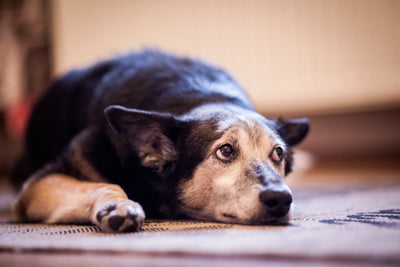How to Brush Your Dog's Teeth

Dog dental disease is one of the most common ailments veterinarians treat. In fact, by the time they are just two years old, 90% of dogs have signs of periodontal disease. Periodontal disease not only causes discomfort to your dog – and that awful breath we hate – but causes other health problems including issues in the kidneys, liver and heart.
Giving your dog a daily meaty bone goes a long way to remove plaque, which turns into tartar after just 72 hours. This creates a vicious cycle, because tartar allows for even more plaque to stick to the teeth easier. That plaque is full of bacteria, which causes inflammation of the gums and, eventually, will lead to the destruction of the bone and tooth, as well as infection that can go into the blood stream and affect other organs. Can’t give bones? Then brushing your dog’s teeth is vital to their health. Here is how to brush your dog’s teeth.
Steps to Brushing Your Dog’s Teeth
Plaque forms on a tooth in just 24 hours, so daily brushing of your dog’s teeth is really the best practice. But even several times a week is better than none.
Get a Pet Toothbrush Kit Together. Start with a dog toothpaste – there are many to choose from at local pet stores, or you can ask your vet for a recommendation – and a dog toothbrush. Never use human toothpaste as it can upset your dog’s stomach. They make electric toothbrushes, manual brushes and finger brushes. As long as it’s made for a dog, it will work. You may want to buy a few and see which one your dog is most comfortable with.
Get Your Dog Use to the Brush and Paste. Don’t just stick your hand in your dog’s mouth and start scrubbing, especially if they nip when nervous. Show them the brushes and paste and allow them to investigate. Put a bit of toothpaste on your finger for them to taste. Dog toothpastes come in different flavours, so if your dog doesn’t seem keen on one, try a different one.
Once they have investigated everything and tasted the toothpaste, use your finger to rub some of the toothpaste onto your dog gums and teeth. Praise them and reward with treats. Do this for a couple days until you are sure your dog is comfortable.
Using the Toothbrush. Then, put some toothpaste on the toothbrush and allow your dog to lick it off. Again, lots of praise and even treat rewards will help them like this process!
Once they are eagerly searching for that brush and paste, it’s time to clean! Brush in short intervals at first, with lots of praise and rewards in between. Vets recommend brushing quickly, so your pet doesn’t get bored.
Stroke the side of their face to pull their lips back. Focus on the outside of the teeth – the inside does not get as much plaque buildup according to vets. Use motions just like you would when brushing your own teeth. Run it along the gum line at a 45-degree angle.
There is no need to rinse out your dog’s mouth like you do when brushing your own teeth.
Once your dog is used to it, toothbrushing becomes a quick and easy part of your daily routine that you can even do it while watching your favourite show every night. And it has a big effect on their health. Remember to still take them for their annual checkups, so a vet can make sure their teeth are looking good because like with everything else, canine periodontal disease is easiest to treat the earlier it’s caught.








